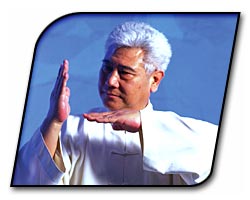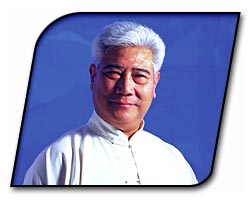| |
 People know taichi as one of the main branches of Wushu. It is one of the Daoist martial arts. But is taichi really what people think it is nowadays? Before 1912 taichi was passed on within unopened circles, (family circles), which at times absorbed things from the outside martial arts world, but what was accepted was strictly restricted. This is why taichi is called ‘internal’. (In the Chinese language, internal martial arts are expressed by the character that means inside or within a family.) After 1912 Mr. Xu Yusheng established a sports research society in Beijing and invited the great masters of that time such as Wu Jianquan, Yang Shaohou, Yang Chengfu and Sun Lutang to teach taichi. Thereafter taichi started spreading to the masses and was then taught relatively openly. Because it then became possible for so many people to study it, the number of people doing taichi rapidly increased. After a while taichi gave form to the modern styles. During their respective development there were various changes in the postures, but these were not so great. We can still now see that all the different schools of taichi have similar postures. It is after these developments that the styles were given their respective names. The popularity of each of them – namely the Chen, Yang, Wu, Wu (Hao) and Sun styles - grew rapidly inside China. The main goal of those teachers was to popularise taichi on a grand scale in order to improve the health of the nation. Another important reason why taichi is so widespread nowadays is the research and exchange that these masters and their students carried out during that period. Nowadays, especially in China, a lot of new styles with a lot of different names are created and mixed with the five original styles without sharing any real roots with them. This is very unfortunate. It not only complicates things but also mixes everything up in a way that brings about many misunderstandings, especially to people who are new to taichi. Wu-style taichi was created by a Manchurian named Quan You (1834 – 1902). Quan You was a student of Yang Luchan, (founder of the Yang style), and Yang Banhou. Quan You’s son, Wu Jianquan (1870-1942), loved martial arts from his youth and studied under the tutorship of his father. By doing so he rapidly improved and deepened his taichi skills. After 1912 he continuously developed the teaching of the wu-style at the Beijing Sport Research Society, gradually refining his father’s style. His two sons, Wu Gongyi and Wu Gongzao, were his first students. Along with other students they rapidly reached a high level of skill. In 1928 Wu Jianquan was invited to Shanghai to teach taichi. In 1935 he established the Jian Quan Association of which he was the director and my father Ma Yueliang was the deputy director. At that time Wu Jianquan went to Hong Kong and Canton as well as numerous other South China cities to spread the Wu-style there. When Wu Jianquan died in 1942 it was a great loss for the taichi world. His sons started to teach taichi all over South China and Wu Gongyi’s son, Wu Dagui, spread the style to South Asia. Wu Dagui’s son, Wu Guangyu, teaches in Canada today.
Wu Jianquan’s eldest daughter, my mother Wu Yinghua (1907 – 1996), started studying taichi with her father at a very young age. In 1935 Wu Yinghua was also appointed deputy director of the Jian Quan Association in Shanghai. She married her father’s student, Ma Yueliang (1901 – 1998), and throughout her life she taught with her husband all over China. In martial arts circles she was regarded as one of the most renowned teachers. Ma Hailong, the eldest son of Wu Yinghua & Ma Yueliang, also liked taichi from a young age and is now the president of the Jian Quan Association. I am Ma Jiangbao the third son of Wu Yinghua & Ma Yueliang. In 1986 I came to Europe to spread the Wu-style and I teach students from many countries such as the Netherlands, Germany, England, Denmark and others. Before 1912 taichi was practised as a fast form. After 1912, because many people came to study taichi in Beijing some of whom had not previously done martial arts, the fast movements and jumps were taken out to make the form more subtle and precise and the stops were removed to comply with the theory of yin and yang. That was the birth of wu-style with its own unique slow form. At the same time Yang Chengfu and Sun Lutang etc created their own styles. Thereafter taichi became a slow form, but the wu-style retained the fast form. The wu-style slow form has such special features as its compactness, and it is relaxed and calm with smoothness from the beginning to the end so that everyone can practise it. The wu-style pushhands (partner exercise) is strictly structured. The body is kept straight and each method is precise and exact. Pushhands should be very soft and smooth. When practising one must try to keep a very calm attitude, not actively trying to attack or use force. My father Ma Yueliang said, "Overcome hardness with softness. To try to use force is in contradiction to the principles of taichi c huan. To meet the hardness with softness is to go along with. To go along with is to neutralize. The important thing for the beginner is to learn neutralizing." The pushhands techniques incorporate single hand and double hand training methods. There are also many different stepping methods, which are learnt after the fixed-step pushhands. The pushhands techniques are a very important part of taichi, and only through its p  ractice is one able to manifest the taichi theory. The wu-style still makes use of weapons such as broadsword, sword and lance. Together with the slow and fast forms and pushhands, wu-style taichi is a traditional system of Chinese martial arts. ractice is one able to manifest the taichi theory. The wu-style still makes use of weapons such as broadsword, sword and lance. Together with the slow and fast forms and pushhands, wu-style taichi is a traditional system of Chinese martial arts. Wu-style taichi is a sport that respects and adapts to the physiology of everyone.
|
|